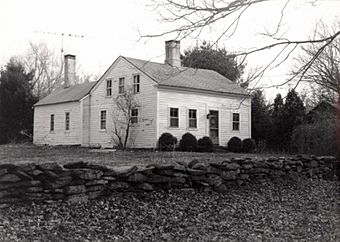Working Girls' Vacation Society Historic District facts for kids
Quick facts for kids |
|
|
Working Girls' Vacation Society Historic District
|
|

The Phebe Howell House
|
|
| Location | 60, 64 and 66 Mill Rd., East Haddam, Connecticut |
|---|---|
| Area | 27 acres (11 ha) |
| NRHP reference No. | 94000557 |
| Added to NRHP | June 3, 1994 |
The Working Girls' Vacation Society Historic District is a special area in East Haddam, Connecticut. It covers about 27 acres and was added to the National Register of Historic Places in 1994. This district is important because its buildings were once owned by the Working Girls' Vacation Society of New York City from 1892 to 1945. These places were used as a summer getaway for young women who worked in the city.
Contents
What Was the Working Girls' Vacation Society?
The Working Girls' Vacation Society was an organization created to help young women who worked hard in cities. It was a lot like the Young Women's Christian Association, which also helped self-supporting women. These groups wanted to support women's well-being in many ways.
Helping Young Women Thrive
In the 1880s, many "working girls' clubs" started across the country. These clubs were often led by kind and wealthy people, like Grace Dodge, who was an heiress. Their main goal was to provide safe and positive places for working women. They offered chances for women to meet new people, learn new things, and have fun in a good environment.
For example, the New York Working Girls' Club, started by Grace Dodge in 1883, had a clubhouse. It had a library, and they held many talks, classes, and social events.
Summer Getaways for Health
The Working Girls' Vacation Society of New York was a part of the Working Girls' Club. It was founded in 1883 to give summer vacations in the countryside to women who had health problems. Important women and social workers helped start this society.
Just like in other cities, the Vacation Society offered low-cost stays, usually for two weeks, in quiet country places. This helped many young women get a break and improve their health. In the summer of 1884, the society helped 411 working girls. By 1915, they had several retreat locations in Connecticut and helped 1,450 women!
Buildings in the Historic District
The historic district includes three properties next to each other on a country road in East Haddam. These properties have three houses and three barns.
When the district was listed, it had six buildings that added to its history and one building that did not. Three of the six important buildings are houses.
The Historic Houses
- The Phebe Howell House: Built around 1835, this house has a strong wooden frame and might still have its original wooden siding.
- The Charles Howell House: Built around 1825, this house has a doorway with decorative columns on each side.
- A Bungalow House: This house was built around 1915 and has a simpler, more common style.
Both the Phebe Howell House and the Charles Howell House were built on strong foundations made of cut granite stones.
The Historic Barns
The other three important buildings are wooden barns from the 1800s. One barn, located at 66 Mill Road, looks similar in size and design to a part of the Phebe Howell House. People say this barn used to be attached to the back of the Charles Howell House.
What Happened to the Society?
In 1950, the association changed its name to the Katherine Herbert Fund. This new name honored Katherine Herbert, who founded the society in 1885. Later, in 1974, it joined with another organization called the Stony Wold Corporation. The Stony Wold Corporation used to focus on helping people with tuberculosis. Together, they became the Stony Wold-Herbert Fund.



